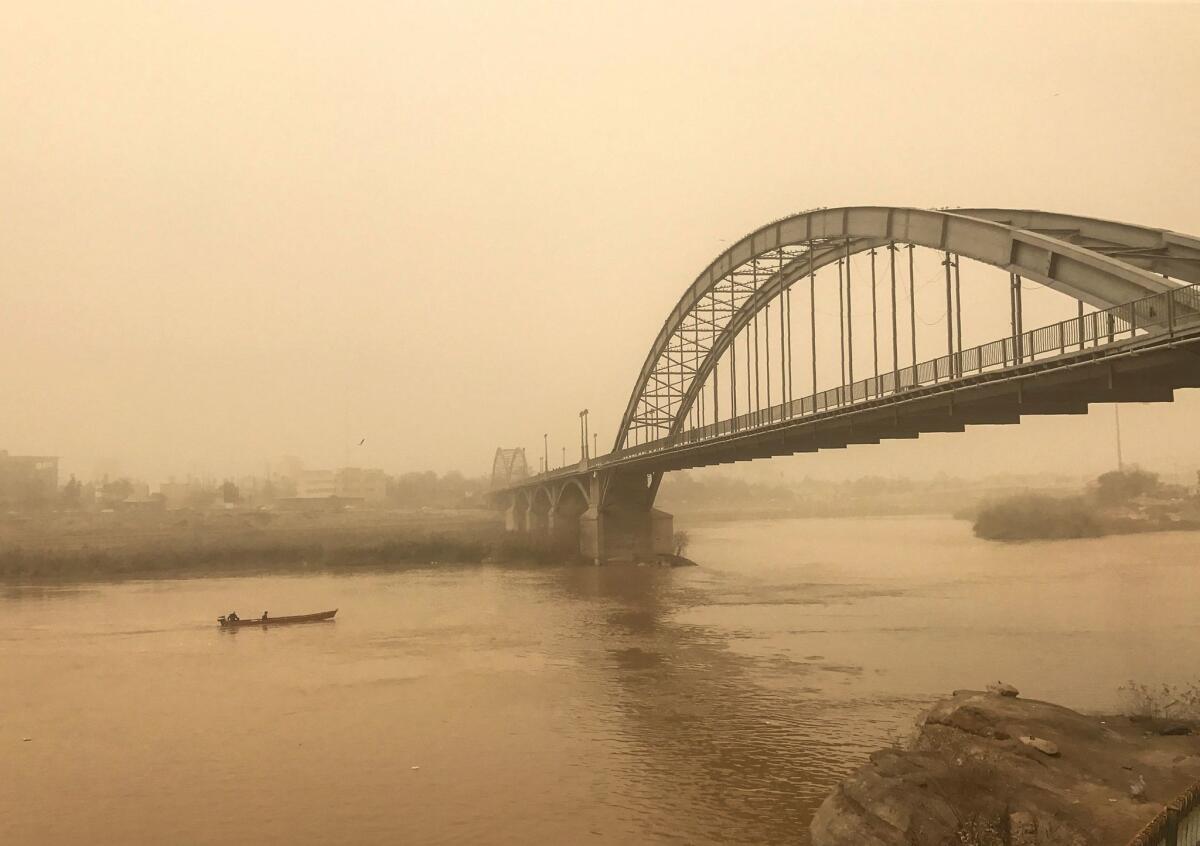Iran’s president tries to defuse anger in an oil-rich province hit by dust storms, blackouts and protests

- Share via
Reporting from Tehran, Iran — Bidding to ease public anger over a mounting environmental crisis, Iranian President Hassan Rouhani on Thursday visited an oil-rich southwestern province that has been crippled by sandstorms and power blackouts.
Residents of Khuzestan province have long struggled with high levels of dust because of desertification, but the problems worsened this month when severe rains washed the fine particles into power transmission equipment. That caused several days of electricity blackouts last week in Ahvaz, the provincial capital and home to more than 1 million people.
Schools and government agencies in much of the province were closed temporarily, and water supplies were disrupted, forcing residents to buy jerrycans of water to drink. Many residents took to the streets of Ahvaz to protest until police issued a warning that anyone participating in “illegal gatherings” would be punished.
Authorities in Tehran, the capital, also prevented a demonstration planned last week to show solidarity with Khuzestan.
Although power and water service has been restored to nearly all the affected areas, Iranian social networks continue to be filled with images of the suffering in the remote province along the Iraqi border. Bathroom sinks are shown lined with dust, which reportedly has seeped into the water supply. A thick brown sludge spills out of the kitchen taps in other photos.
The widening outrage prompted Iran’s supreme leader, Ayatollah Ali Khamenei, to express his concern this week, saying, “What has happened in Khuzestan province has caused heartache for any human being.”
Meteorological reports from the area said that a large dust cloud approximately 60 miles long blew in from the drought-hit marshlands of Iraq and sat over Ahvaz. Residents said the particles settled on electricity transmission lines and caused blackouts.
Mansour Qasemi, a 52-year-old civil engineer in Ahvaz, said that whenever the city is lashed by such dust storms, “life instantly goes back to the Stone Age.”
“There is dust everywhere — in your mouth, hands, stomach. There is no electricity, no landline phone, no Internet. You are desperate,” Qasemi said by phone. “You are excommunicated from the 21st century for a few days.”
The misery has become all the more sensitive because Khuzestan is the source of much of Iran’s oil production and hydroelectric power. Gas flared from oil facilities is blamed for high levels of pollution and respiratory problems that worsen during heavy rain and wind.
In fall 2013, following a rainstorm in Ahvaz, 12,000 people were admitted to hospitals and 3,000 were diagnosed with shortness of breath over 10 days, according to researchers. The World Health Organization has ranked the city as having some of the worst ambient air quality in the world.
The mainly ethnic Arab residents suffer from widespread unemployment and have long complained of ethnic discrimination and neglect by the central government in Tehran.
“You ask yourself: Am I not living in Iran, in oil-producing Khuzestan?” Qasemi said. “Is Tehran the center of the universe?”
On Thursday, Iranian state media reported that Rouhani visited a water-treatment plant and pledged to open a long-promised facility that would allow gas to be stored and generate electricity instead of being flared into the skies.
Agriculture officials also announced plans to plant more than 115 square miles of trees and green cover in an effort to stem the churning of the dust storms.
Unconvinced that the government will solve Khuzestan’s woes, many residents have moved.
Tapereh Sikaroudi, a 50-year-old retired English teacher, said the dust particles in the air in Ahvaz caused her to develop a skin allergy. She moved to Tehran but had to leave behind her husband, who remains in Ahvaz for work.
“I think that in the years to come, we will witness the exodus of Ahvaz inhabitants to other towns and cities,” she said.
Special correspondent Mostaghim reported from Tehran, Iran, and Times staff writer Bengali from Mumbai, India.
Follow @SBengali on Twitter for more news from South Asia
ALSO
In Guatemala, Trump’s Homeland Security chief contradicts new immigration directives
Iran’s supreme leader rejects calls to release leaders of 2009 Green Movement protests
Islamic State fires cluster bombs at Iraqi government forces
More to Read
Sign up for Essential California
The most important California stories and recommendations in your inbox every morning.
You may occasionally receive promotional content from the Los Angeles Times.











